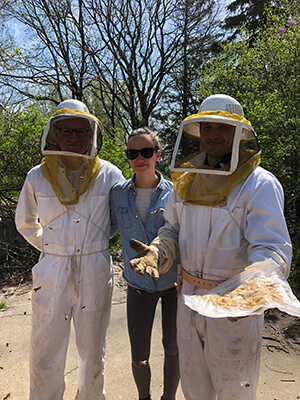
No beekeeper wants their bees to develop infections of Paenibacillus larvae, the bacteria causing American Foulbrood (AFB). It’s deemed such a threat that colonies must be destroyed if positive detections are found. In addition, neighboring colonies in an apiary or operation must be quarantined, which can significantly impact beekeepers, especially those who need to move their colonies on a schedule.
While few formal surveys have been conducted, it’s well-known that some beekeepers prophylactically treat their colonies with antibiotics to ward off AFB. But this practice comes with a cost. Similar to how several antibiotics are losing their efficacy to combat human bacterial diseases due to improper use, antibiotic-resistant strains of AFB have been detected for the past several years, presumably due to the prophylactic treatments applied by beekeepers. In other words, new strains of AFB are evolving that can survive antibiotics, and those strains pose an even larger threat to beekeepers.
But what if instead of using prophylactic antibiotics, beekeepers could use prophylactic probiotics to combat AFB? That could be a simple, elegant, and potentially cheap way to protect colonies from AFB while avoiding the development of resistant strains. But is it possible? This is the topic for our twenty-sixth “Notes from the Lab,” where we highlight “Novel probiotic approach to counter Paenibacillus larvae infection in honey bees,” written by Brendan Daisley and colleagues and published in the ISME Journal (2019).
For their study, Daisley and colleagues first took advantage of a fortuitous natural outbreak of AFB in one of their apiaries. (Yes, most beekeepers would consider an AFB outbreak anything but fortuitous, but remember these beekeepers are scientists studying AFB!) Next, they also complemented this observational study with manipulative lab experiments isolating the influence of microbes on P. larvae and larval survival. This combination of field observations and controlled laboratory studies can be an excellent 1-2 punch for advancing scientific knowledge on a topic, in this case the impact of probiotic bacteria on AFB.
Specifically, the field experiment followed six colonies, two of which were controls (no treatment), two that were supplemented with vehicle controls (pollen patty and a buffered solution without probiotics), and two of which were supplemented with the probiotic treatment (pollen patty and the buffered solution containing probiotics, which the authors call a BioPatty). The authors cultured three bacteria to make their probiotic BioPatty: Lactobacillus plantarum Lp39, Lactobacillus rhamnosus GR-1, and Lactobacillus kunkeii BR-1.
Previous studies in fruit flies found these three strains of bacteria could improve innate immunity, pesticide detoxification, and protection against harmful microorganisms, hence the interest in these specific bacteria by the researchers. The colonies were administered their respective treatments twice (day 0 and day 7) and nurse bees were collected for later screening on each of these days. Colonies were identified as positive for AFB on day 12 and were thus destroyed on this date as per government regulations after larval samples were collected from the infected hives. The nurse bees and larvae were subsequently tested for differences in bacterial communities depending on whether they were taken from treatment or control colonies.
Next, the authors conducted two sets of follow-up laboratory experiments. First, they isolated and cultured the P. larvae strain from their infected colonies and challenged this strain in Petri dish assays with probiotic bacteria, bacteria isolated from honey bee guts, and antibiotics. If you’re unfamiliar with Petri dish assays, think about that ….


